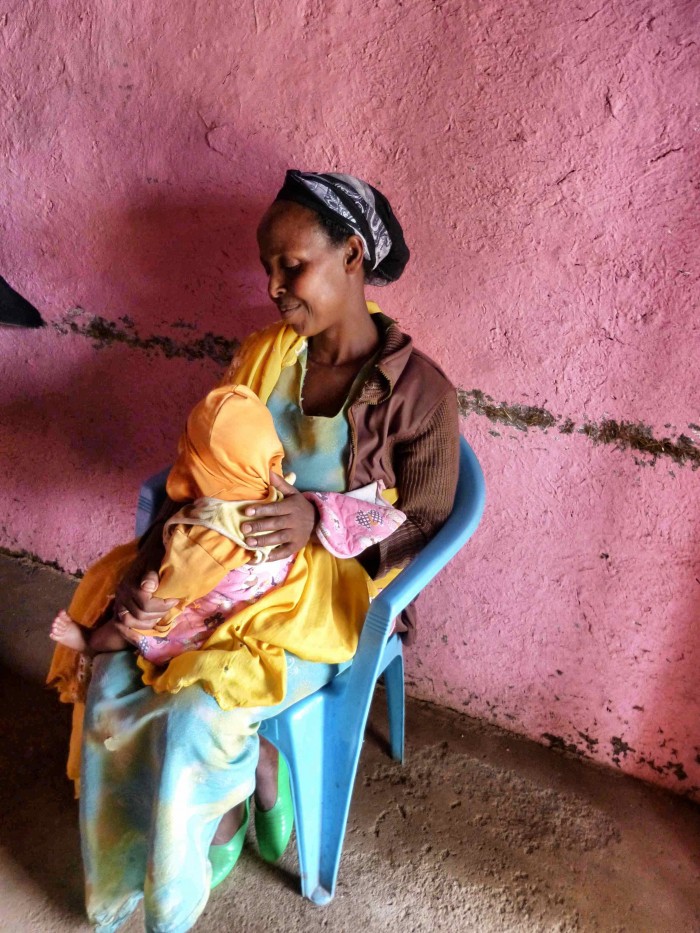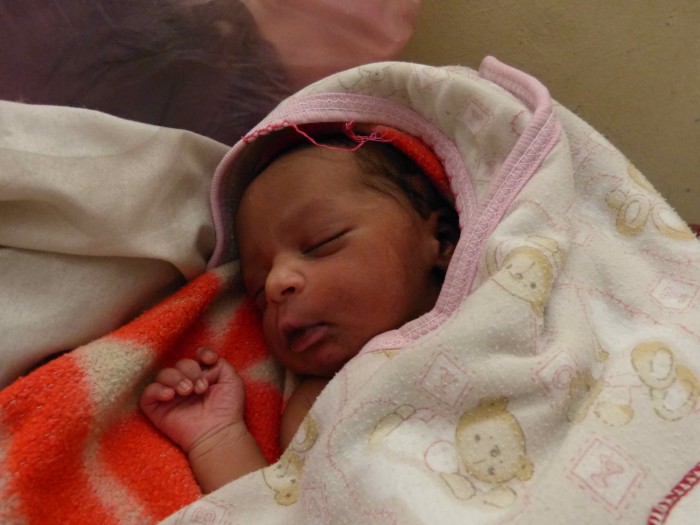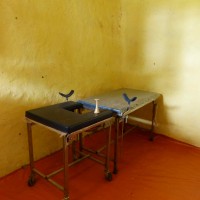Above: Menesch cradling her with-child in her lap at the Lie and Wait house in rural Ethiopia.
“If she wasn’t bleeding, she would have suffered like I did and delivered at home,” said Fasika’s* mother Menesch at a Lie and Wait center for expectant mothers in rural Ethiopia.
Menesch was inside the room with her expecting daughter Fasika while nursing her three-month-old daughter on a chair. It was Menesch’s eighth child who, like all the rest, she delivered at home with no trained labor assistant.
Fasika was a mere 15 years old with baby fat still surrounding her cheeks and a shy smile that often looked down at her largely pregnant belly. Meeting Fasika and her mother on the last day of my trip was the defining moment of my two weeks of reporting on maternal and newborn health in Ethiopia.
I went to Ethiopia as a reporting fellow with the International Reporting Project with the goal of gaining a better understanding of the country’s comprehensive health care system established to save the lives of mothers and babies who are at serious risk of dying during and after childbirth.
We met with health extension workers, doctors, midwives, expectant mothers, new mothers and NGOs in both rural and urban settings to get a clear understanding of how Ethiopia, one of the poorest countries in the world, achieved Millennium Development Goal 4—reducing child mortality rates for children under five by two-thirds—well ahead of the 2015 deadline.
We saw the remarkable progress that has been made and the lives that have been saved thanks to the government’s commitment to improving access and quality of maternal and child health.
Yet, there in the dark, mud walls of the Lie and Wait center we heard the story that painted the real picture of the work that remains to be done in saving the lives of Ethiopia’s mothers and newborns, particularly within the birthing process and the first 28 days of life which are the most dangerous days to be alive for a baby.
Above: A nine day old baby who was has a good chance of survival as one of the 20 percent of children born in a hospital in Ethiopia.
Although progress has been made for both mothers and children under age five (since 2000, the maternal death rate has decreased from 1 in 24 to 1 in 67 and child mortality rates have been declining 6.1 percent annually), neonatal mortality rates have not seen as much progress and still contribute to 42 percent of all child under five deaths. (Source: Save the Children – Ethiopia).
There are still 118,000 newborn deaths every single year in Ethiopia.
One of the main causes of such high rates of maternal and newborn mortality is the fact that 80 percent of Ethiopian women give birth at home with no trained labor assistant.
To combat maternal, child and newborn deaths the Ethiopian government has trained and deployed an army of over 38,000 Health Extension Workers (HEW) who have been critical to Ethiopia’s amazing success story at reducing child under five deaths as well as maternal deaths. These women are selected, trained and paid by the government to live within and cover a rural Health Post that serves up to 5,000 people within the community. The HEW program launched in 2003 and has saved many lives.
We visited one Health Post in the village of Mosebo to get a better understanding of the services they provide. The Health Post is part of the Ethiopian government’s three-tier health care system to reach its 90 million people, of which 85 percent are located in remote, rural areas. There are currently 16,000 Health Posts like Mosebo in Ethiopia yet the country needs many more as some people walk as much as two hours or more on foot through difficult, mountainous terrain to reach a Health Post.
The more I traveled through Ethiopia, the more evident it became that many people have never even met a health extension worker or had any professional health services before.
- The outside of the Health Post in Mosebo village.
- A Health Extension Worker shows us how she documents her visits to patients in Mosebo Village.
- Examination room inside Mosebo Health Post which serves a population of 5,000 people.
Every Health Post is linked to a Health Center where expectant mothers are urged to give birth by a trained birth assistant. There are currently 3,500 Health Centers in Ethiopia and only 130 Hospitals, serving 90 million people.
Per the Ministry of Health, 185 new hospitals are in the process of construction and hopefully will be completed soon. However, visiting an urban and regional hospital proved that even with the new hospitals it still may not be enough. Lines of patients and their families waiting for hours to be seen is a common sight in an Ethiopian hospital. Furthermore, only 19 percent of all Ethiopian women receive prenatal care and only 7 percent for postnatal care.
The infrastructure of Ethiopia is also significantly improving yet remains lightyears behind the country’s massive needs. Some villages are so remote and rural, that it can take a laboring mother hours on foot to reach the nearest health post or center.
If she has complications, the only way to reach the nearest gravel road may be by “traditional ambulance” which basically means the woman is carried on a wooden stretcher for sometimes up to two hours to reach a dirt road where she can be transported to a hospital.
If the torrential rains come like they often due in winter, the dirt roads become impassable. Obviously improving the roads in rural Ethiopia will save many maternal and newborn lives.
Above: Some of the beautiful children I met in rural Ethiopia. Reaching their village only 42 kilometers away took over two hours by Land Cruiser. If it had rained, the mud roads would be impassable.
After meeting Fasika and her mother at the Lie and Wait house in rural Ethiopia, I realized that much work remains to be done to save Ethiopia’s mothers and newborns.
Roads, health centers, and hospitals need to be expanded and built, doctors and midwives need to be trained, and most importantly, millions of Ethiopian’s need to be educated on the importance of pre and post natal care and of delivering in a health facility.
Fasika and her mother had never seen a health practicioner in their lives and Fasika would have delivered her child at home like her mother if it weren’t for complications.
Long held traditions, cultures and beliefs such as child marriage and desire to birth at home, need to be changed which will take time. There is hope for Ethiopia’s mothers and their children. As long as more progress is made, no woman or child should die so invisibly from a preventable cause.
Above: 15-year old Fasika was married at 12 which is illegal in Ethiopia but often unreported. She is expecting her first child any time.
This post is based on my reporting trip to Ethiopia with the International Reporting Project.
*All names have been changed to protect privacy.
Love elephant and want to go steady?
Sign up for our (curated) daily and weekly newsletters!
Editor: Catherine Monkman
Photos: Courtesy of Author















Read 0 comments and reply